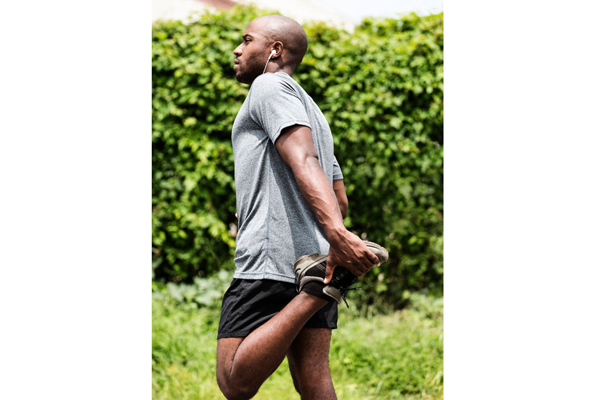The importance of stretching

You may think of stretching as something performed only by runners or gymnasts. But we all need to stretch in order to protect our mobility and flexibility. PHOTO | SHUTTERSTOCK
According to health.harvard.edu, stretching keeps muscles flexible, strong, and healthy, and we need that flexibility to maintain a range of motion in the joints. Without it, the muscles shorten and become tight. Then, when you call on the muscles for activity, they are weak and unable to extend all the way. That puts you at risk for joint pain, strains, and muscle damage.
For example, sitting in a chair all day results in tight hamstrings in the back of the thigh. That can make it harder to extend your leg or straighten your knee all the way, which inhibits walking. Likewise, when tight muscles are suddenly called on for a strenuous activity that stretches them, such as playing tennis, they may become damaged from suddenly being stretched. Injured muscles may not be strong enough to support the joints, which can lead to joint injury.
Experts recommend stretching before and after exercise. However, there is a danger in stretching a tight muscle, especially before one starts exercising.
“A number of people stretch before starting to exercise as a way to warm up. However, this is not recommended and can only culminate in injury since the muscles are not warm. It is like bending hard plastic; chances are, it will break. Before one starts exercising, muscles are tense and stretching will lead to microscopic tears to the tissue,” Timothy Musaazi, a fitness trainer, says.
He adds that when warming up before an exercise, opt for workouts such as a brisk walk. Eva Lwasa, a personal trainer, says there are several benefits of stretching including:
Improved mobility
Mobility is how well you move when engaging in a particular workout or activity. “For example, how well do you go up that staircase; can you bend to pick up things from the bottom drawer? One can only do these activities if they have strong, stretched muscles,” Lwasa says.
Flexibility
This looks at the range of motions you can make using a joint or a group of joints. “For example, while some will easily touch the tip of their right shoulder blade using the left hand, another will find it hard,” she adds.
Stronger muscles
Lwasa says when muscles are stretched, the muscle tissue is lengthened and becomes more flexible, which allows one to do strength building manoeuvres with greater mobility. Also, as one stretches, blood circulation is improved, thus feeding nutrients to hungry muscles which allows them to grow. Stretching also rids one of muscle soreness, reduces back pain, relaxes the body, and improves overall muscle functionality.
Types
Passive stretches: Also referred to as assisted stretching, one needs some assistance to perform a stretch. Musaazi says the assistance could come from a strap as well as one’s own weight or gravity. “It is about grabbing onto something to do the stretch while you relax your muscles,” he says.
Active stretches: This is using an opposing muscle to work another. “For example, one can lay on the back while lifting their leg to the ceiling until they feel the hamstring stretch,” Lwasa shares.
Dynamic stretches: Regardless of whether you are doing active or passive stretches, you can do a dynamic stretch, which is all about motion and in this case, a certain body part is moved in a controlled radius.
Static stretches are those in which you stand, sit or lie still and hold a single position for period of time, up to about 45 seconds.
In a dynamic or active stretch, you go through the same motions but this time switch sides while holding each position for 10 to 30 seconds. Do this fluid movement for 10 to 15 times.
Ballistic stretches: They are similar to dynamic stretches but while these move the body part to the end of its motion range, ballistic stretches go beyond. According to Musaazi, these are ideal for people that are extremely flexible such as gymnasts or ballet dancers as these incorporate such moves in their routines. Therefore, others should cautiously engage in them since they may result in injuries.
How to stretch
Stretching is best done, as earlier seen, after working out because it is easier to work with warm muscle tissue. When stretching, Lwasa says, focusing on variety, strength and balance is important.
According to Lwasa, one should hold a stretch for 30 seconds. “Do not bounce, which can cause injury. You will feel tension during a stretch, but you should not feel pain. If you do, there may be an injury or damage in the tissue. Stop stretching that muscle and talk to your doctor,” she advises.
Tips
Strive for symmetry. Everyone’s genetics for flexibility are a bit different. Rather than striving for the flexibility of a dancer or gymnast, focus on having equal flexibility side to side (especially if you have a history of a previous injury). Flexibility that is not equal on both sides may be a risk factor for injury.
Focus on major muscle groups. Concentrate your stretches on major muscle groups such as your calves, thighs, hips, lower back, neck and shoulders. Make sure that you stretch both sides. Also stretch muscles and joints that you routinely use.
Do not bounce. Stretch in a smooth movement, without bouncing. Bouncing as you stretch can injure your muscle and actually contribute to muscle tightness.





